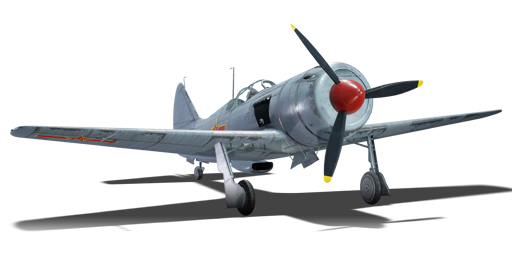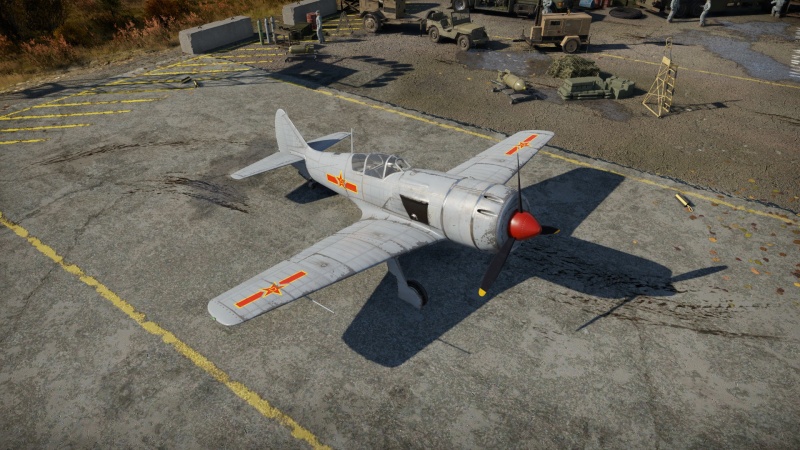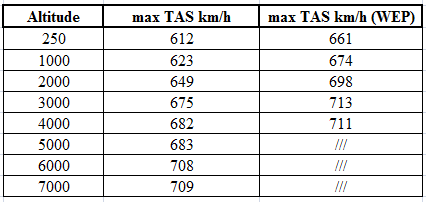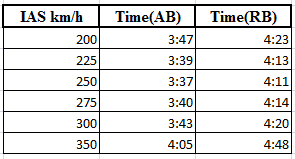La-9 (China)
| This page is about the Chinese fighter La-9 (China). For other variant, see La-9. |
Contents
Description
The ␗La-9 is a rank IV Chinese fighter with a battle rating of 6.3 (AB) and 6.0 (RB/SB). It was introduced in Update 1.91 "Night Vision".
General info
Flight performance
| Characteristics | Max Speed (km/h at 6,250 m) |
Max altitude (metres) |
Turn time (seconds) |
Rate of climb (metres/second) |
Take-off run (metres) | |||
|---|---|---|---|---|---|---|---|---|
| AB | RB | AB | RB | AB | RB | |||
| Stock | 662 | 642 | 13000 | 22.1 | 22.7 | 14.3 | 14.3 | 550 |
| Upgraded | 721 | 690 | 20.5 | 21.0 | 25.6 | 19.2 | ||
Details
| Features | ||||
|---|---|---|---|---|
| Combat flaps | Take-off flaps | Landing flaps | Air brakes | Arrestor gear |
| ✓ | ✓ | ✓ | X | X |
| Limits | ||||||
|---|---|---|---|---|---|---|
| Wings (km/h) | Gear (km/h) | Flaps (km/h) | Max Static G | |||
| Combat | Take-off | Landing | + | - | ||
| 850 | 320 | 520 | 400 | 290 | ~13 | ~8 |
| Optimal velocities (km/h) | |||
|---|---|---|---|
| Ailerons | Rudder | Elevators | Radiator |
| < 480 | < 340 | < 570 | > 341 |
| Compressor (RB/SB) | ||
|---|---|---|
| Setting 1 | ||
| Optimal altitude | 100% Engine power | WEP Engine power |
| 1,700 m | 1,670 hp | 1,959 hp |
| Setting 2 | ||
| Optimal altitude | 100% Engine power | WEP Engine power |
| 4,000 m | 1,460 hp | ?,??? hp |
Survivability and armour
- No armour plating
- No armour glazing
- Critical components located at front of aircraft (fuel, pilot, engine, controls)
- More fuel tanks located in wings near the fuselage
Modifications and economy
The two most important modules that should be unlocked as soon as possible are the Offensive 23 mm belts and Engine injection. The first gives access to the devastating air target ammo belt while the second one gives a huge boost to the fighters flight characteristics. Difference between a completely stock and a fully upgraded plane is huge (see screenshots in post below), and the first 50 or so battles will be very challenging.
The recommended order of research is as follows:
- Offensive 23 mm belts
- Radiator
- Compressor
- Engine
- Wings repair
- Engine Injection
- Everything else, based on personal preferences
The total amount of Research Points(RP) necessary to unlock all modules on the La-9 lies at 167000 RP and makes it the most expensive plane in terms of RP to upgrade in all of Soviet rank IV planes. Curiously enough only 120000 RP are needed to research the plane itself.
One other camouflage besides the default one is currently available – Unicolor Grey Camouflage, which requires 350 enemies destroyed while in the La-9 to be unlocked.
Armaments
Offensive armament
The La-9 (China) is armed with:
- 4 x 23 mm NS-23 cannon, nose mounted (75 rpg = 300 total)
Usage in battles
Arcade Battles: As all planes, the La-9 has a boosted Flight Model (FM) in the Arcade mode, which allows for better overall performance, from speed and climb rate to manoeuvrability. It performs best at an altitude of 3400 m and below. The main reason for this is the absence of War Emergency Power (WEP) at altitudes above 4000 m. To be able to use WEP at altitudes between 3,400 m – 4,000 m it is necessary to maintain a good speed.
In terms of top speed, a fully upgraded La-9 is among the fastest planes at sea level in the game, allowing it to easily outrun most opponents. The acceleration is good even without WEP, but with it, becomes amazing, however, keep in mind not to overuse it and thus overheating the engine. Although it can be cooled off easily by lowering the throttle, thanks to the ASH-82FN being an air-cooled engine, once overheated both the top speed as well as acceleration take a noticeable loss in performance.
The La-9 is not a particularly manoeuvrable plane and should avoid dogfights in most cases as even if won, they are likely to take long enough and leave the plane low on speed – a tempting target for other enemy fighters.
The climb rate of the plane is great until the fighter reaches 4000 m after which it becomes somewhat moderate in comparison to other planes at rank IV, due to the absence of WEP at higher altitudes. The best IAS (Indicated airspeed) for climbing is 250 km/h.
Another important trait of this fighter is its energy retention, in arcade battles, it is possible to safely dive from 4,000 m to 1,000 m and still be able to recover all that altitude, it also helps to keep flying at above max speed after a dive longer than the average competition at its level.
In Ground Strike battles, La-9 pilots have two choices:
Helping to secure altitude and bomber hunting/escorting – A high risk/high reward option, best attempt this if the La-9 is almost or already fully upgraded. At the start of the battle side climb for a bit, but don't get too separated from friendly fighters that are also climbing. It is important to avoid the initial clash since the La-9 isn't very manoeuvrable and with numerous enemies flying around – an easy target. Instead, provide cover for one of the more nimble teammates that have engaged in a dogfight. Once air superiority has been established, either pursue enemy bombers or escort friendly bombers by shooting down any climbing attackers. Should the team fail in establishing air superiority, don't stay up high as the La-9 gets outperformed by most fighters at higher altitudes. Focus on any enemy bombers within reach and then proceed to the second option.
Covering ground targets and attacking low flying enemies – A relatively low risk/decent reward option, the most appropriate when the player doesn't have the plane upgraded (i.e. when it is in "stock" condition). The best way to do this is to fly the La-9 an altitude of 2,000 m - 3,000 m and to position it either at the flanks of the map or directly in front of friendly fighter spawn. A certain distance is to be kept from the core of the enemy airspace, whilst attacking low flying bombers and attackers to protect friendly ground targets, or whilst finding and engaging a furball from above and performing Boom and Zoom attacks on the enemy fighters below. In case of danger, speeding away towards the enemy team's fighter spawn ought to resolve any issues.
Domination mode is arguably the best mode for the La-9 because most enemies are flying below 4,000 m and are thus always allowing the fighter to perform at its best. The approach to Domination battles is always simple yet effective. With the plane above contested airspace at around 2,500 m altitude, one should dive down on an enemy, shoot and extend towards teammates. Once safe, it is time to regain altitude and repeat the process. The La-9 is also capable of quickly capturing airfields since it's powerful 23 mm cannons can be fired to use the recoil as a quasi-airbrake.
In the Realistic and Simulator modes the FM of the La-9 is no longer boosted in any way. However, the plane is still at its best below 4000 m, as the WEP is unavailable above 4000 m just as in the arcade mode. The speeds required to apply WEP at altitudes from 3000 m to 4000 m vary slightly from those in AB, but the main idea remains the same – high speed is required.
In realistic and simulator battles start by climbing to an altitude of 2,500 m (if cloudy) or 3000 m (if the weather is clear). Climbing higher than that is only advised if not alone as the La-9 will be outperformed at high altitude by most enemies. The key to success in the La-9 is teamwork, so consider squading up with a friend. Since it is a bad idea to dogfight, try to get an enemies attention by acting as bait and lure him down to sea level instead. Once the enemy loses his altitude advantage, it is time for the squadmate to attack. Once low, the pursuer won't be able to either catch the bait nor escape your ally – presenting themselves as an easy target. Be also sure to target any enemies that are flying low, if the La-9 has an altitude advantage use Boom & Zoom tactics, if the plane is on the same low altitude as the enemy, perform high-speed fly-bys.
Even if not as fast as in arcade battle, it remains among the fastest fighters at low altitude in RB and SB, while also having great acceleration with WEP applied. Keep in mind that this only applies, if the engine isn't overheated – to cool it off, lower the throttle; it will only take a couple of seconds.
Both the manoeuvrability and the climb rate take a drop in performance as well, but the general rule stays the same. Try to avoid dogfights and don't climb above 4,000 m unless not alone or there are no enemies above the La-9. The best IAS for climbing remains 250 km/h.
While the energy retention of the La-9 after a dive in RB and SB is great, one shouldn't dive for more 2 -2,5 km at a time, because the plane quickly reaches its maximum allowed speed of 850 km/h IAS or roughly 910 km/h TAS (true airspeed, default speed measurement). Not only that but at speeds above 750 km/h IAS it becomes hard to pull up from a dive due to noticeable control stiffening.
A separate characteristic of the fighter which only really comes into play in RB and SB is the minimal amount of fuel a player can take into battle, which is currently enough for 45 minutes of flight time. In prolonged matches it allows the La-9 to simply outlast its enemies. Once around half of the fuel is consumed an increase of the fighters speed, climb rate, but most importantly roll rate becomes noticeable which is likely to come in handy late game.
This last feature is currently only really useful for SB players. The La-9 is currently one of the planes for which the canopy of the cockpit can be opened to improve the visibility at the expense of some top speed.
Specific enemies worth noting
When fighting German aircraft, the toughest opposition will be late Bf 109's and aircraft of the Fw 190 D series (together with their cousin, the Ta 152 H-1).
The former are deadly opponents above 4,000 m that are well capable of outmanoeuvring the La-9 due to the Soviet fighter's absence of WEP at high altitudes, having also an advantage in regards to climb rate. This leaves the La-9 pilot with two options, either acting as bait - making the 109 loose energy and become vulnerable - or diving down. At lower altitudes, the La-9 regains a fighting chance, but it is usually a tense battle where the deciding factor will be the pilot's individual skill. Don't forget to use combat flaps.
Fw 190 D series/Ta-152 – similar to the Bf 109, these German aircraft possess a climb and also a speed advantage above 4000 m. However, they will be out-turned by the La-9 in the horizontal, though it may take a while. At lower altitudes, these planes are easy targets as they hold no significant advantages, except for roll rate and considerable firepower. It is unwise to perform head-on attacks against them.
When fighting British aircraft, naturally, different tactics are to be employed.
Late Spitfires, such as the Mk. XVIIIe or the Mk. 22 variants, can easily out-do the La-9 in the department of turn radius, so employing turn-heavy tactics is heavily discouraged. Their well-performing Rolls-Royce Griffon engines also grant them a better output at higher altitude, which means that fighting above 4,000 m for the La-9 puts the Soviet pilot at a disadvantage. These Spitfires, however, are not as fast as the La-9 nor do they manoeuvre as well at high speed. Therefore, engagements against these aircraft should consist of Boom & Zoom and Boom & Run oriented tactics.
The Tempest Mk II is of, all piston-engine enemies, the La-9's most deadly adversary. Any opportunity to engage one in an advantageous situation should be seized - lest the Tempest is given the upper hand and the La-9 becomes prey. Unlike other piston-engine planes, the Tempest is among those few planes that can rival the La-9 in terms of top-speed at lower altitudes. Climb rate and turn rates are similar, but the British fighter has the edge. To defeat one, very skilful defensive flying is required. The best course of action is to set the Tempest up for an attack on a teammate. One factor that can prove to decide on both sides is knowing how to use Manual Engine Controls.
Counter-tactics
The best way to fight the La-9 is by exploiting its weaknesses – poor manoeuvrability in dogfights and poor high altitude performance. If flying a more manoeuvrable plane (F8F-1B, Spitfires, Ki-84, N1K2 or Yak-9UT), turn-intensive tactics are recommended. If the La-9 commits to it, it would be easy to destroy it, if not, one ought to climb and employ the tactics recommendable when flying less manoeuvrable fighters.
A less nimble plane (Fw 190, Bf 109 K, F7F etc.) should, once above 4000 m hold on to that altitude and get in position for Boom & Zoom runs. The only way to catch the La-9, if it is going at full speed at low altitude, is by diving on one, so an altitude advantage is a key to success.
Manual Engine Control
| MEC elements | ||||||
|---|---|---|---|---|---|---|
| Mixer | Pitch | Radiator | Supercharger | Turbocharger | ||
| Oil | Water | Type | ||||
| Controllable | Not controllable | Not controllable | Not controllable | Separate | Not ontrollable | Not controllable |
Pros and cons
Pros:
- Excellent performance at low altitudes(< 3,400 m)
- Amazing top speed at low altitudes
- Great energy retention
- Powerful nose-mounted weaponry
- Responsive control surfaces
- Sturdy Damage Model
- Very good acceleration (especially with WEP enabled)
- High rate of fire
- Ability to fire only half the guns (enabling better ammo conservation and recoil control)
Cons:
- Maneuverability not good enough for dog fights with most opponents
- Poor performance at higher altitudes (> 4,000 m)
- Low ammo capacity
- Powerful recoil
- Bad overall ballistics of the NS-23 guns
- Poor cockpit visibility
History
Describe the history of the creation and combat usage of the aircraft in more detail than in the introduction. If the historical reference turns out to be too long, take it to a separate article, taking a link to the article about the vehicle and adding a block "/History" (example: https://wiki.warthunder.com/(Vehicle-name)/History) and add a link to it here using the main template. Be sure to reference text and sources by using <ref></ref>, as well as adding them at the end of the article with <references />. This section may also include the vehicle's dev blog entry (if applicable) and the in-game encyclopedia description (under === In-game description ===, also if applicable).
Media
- Skins
- Videos
See also
Links to the articles on the War Thunder Wiki that you think will be useful for the reader, for example:
- reference to the series of the aircraft;
- links to approximate analogues of other nations and research trees.
External links
Paste links to sources and external resources, such as:
- topic on the official game forum;
- encyclopedia page on the aircraft;
- other literature.
Official data sheet - more details about the performance (Russian Forum)
| Lavochkin Design Bureau (Лавочкинa Опытное конструкторское бюро) | |
|---|---|
| LaGG-3* | I-301 · LaGG-3-4 · LaGG-3-8 · LaGG-3-11 · LaGG-3-23 · LaGG-3-34 · LaGG-3-35 · LaGG-3-66 |
| La-5/7 | La-5 · La-5F · La-5FN · La-7 · Dolgushin's La-7 · La-7B-20 |
| La-9/11 | La-9 · La-11 |
| Jet Fighters | La-15 · La-174 · La-200 |
| Export | ␗La-9 · ␗La-11 |
| Captured | ▀La-5FN |
| *Lavochkin-Gorbunov-Gudkov (Лавочкин-Горбунов-Гудков), head designer V. P. Gorbunov | |
| China fighters | |
|---|---|
| British | ␗Gladiator Mk I |
| French | D.510C |
| Japanese | ␗A6M2 · ␗Ki-27 otsu · ␗Ki-43-III ko · ␗Ki-44-II hei · ␗Ki-61-I otsu · ␗Ki-84 ko |
| American | CW-21 · Hawk III · P-66 · ␗P-40E-1 · H-81A-2 · ␗P-43A-1 · ␗P-47D-23-RA · ␗P-47D-30 · ␗P-51D-20 · ␗P-51K |
| Soviet | ␗I-15bis · ␗I-153 M-62 · ␗I-16 Chung 28 · ␗I-16 type 5 · ␗I-16 type 10 · ␗I-16 type 17 · ␗La-11 · ␗La-9 |







